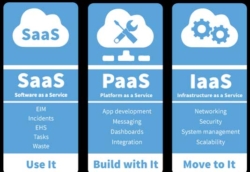Navigating the Evolving Cloud Landscape: Strategies for Success in 2024

Due to the significant advancements in the IT industry, the adoption of cloud computing has rapidly shifted from being a mere concept to an essential requirement for companies of all sizes across various sectors. However, merely selecting a cloud service provider and a compatible architecture is not enough. To fully leverage the potential of this technology, a thorough reassessment of existing operations, processes, and business culture may be necessary.
According to Gartner, it is projected that seventy percent of enterprise workloads will migrate to the cloud by 2024. Despite this, three out of four organizations lack a suitable cloud strategy. Regardless of their stage in the cloud journey, every business requires a well-defined cloud strategy. A comprehensive cloud strategy should be business-driven, addressing key issues of “what” and “why,” and aligning closely with the organization’s overarching business objectives.
What is a cloud strategy?
A cloud strategy refers to a company’s plan for adopting and using cloud computing services and resources. It can include the following key elements: cloud adoption roadmap, cloud service model evaluation, cloud provider evaluation, cloud governance, and application modernization. Overall, a cloud strategy enables a company to adopt cloud computing in a systematic and well-defined and governed manner. Below are some key components of a robust cloud strategy:
- Cloud Adoption Roadmap: This outlines the phased approach or timeline for migrating different applications, workloads, and data to the cloud. It includes prioritization of systems, dependencies, and timelines for migration, ensuring minimal disruption to ongoing business operations.
- Cloud Service Model Evaluation: Organizations need to assess which cloud service model—Infrastructure as a Service (IaaS), Platform as a Service (PaaS), or Software as a Service (SaaS)—best fits their requirements. Each model offers different levels of control, scalability, and management responsibilities, and evaluating these options helps in making informed decisions.
- Cloud Provider Evaluation: Choosing the right cloud service provider is crucial for the success of a cloud strategy. Factors such as reliability, security, performance, compliance, pricing, and geographical presence need to be considered when evaluating potential cloud vendors. Organizations may also assess the provider’s track record, customer support, and service-level agreements (SLAs).
- Cloud Governance: Cloud governance involves establishing policies, processes, and controls to ensure compliance, security, and cost management across the cloud environment. It includes defining roles and responsibilities, implementing access controls, monitoring usage, enforcing security policies, and optimizing resource allocation to align with business objectives.
- Application Modernization: As part of the cloud strategy, organizations often undertake application modernization initiatives to refactor or re-architect legacy applications for cloud-native environments. This involves redesigning applications to leverage cloud-native features such as scalability, elasticity, microservices architecture, and DevOps practices, thereby improving agility, resilience, and efficiency.
- DataManagement and Security: Effective data management and security measures are integral to any cloud strategy. This includes defining data governance policies, implementing encryption, access controls, and data loss prevention mechanisms, as well as establishing backup and disaster recovery solutions to safeguard critical data assets in the cloud.
- Continuous Optimization and Innovation: Cloud strategy is an ongoing journey, and organizations need to continuously optimize their cloud resources and embrace emerging technologies to drive innovation and maintain competitiveness. This involves monitoring performance, analyzing usage patterns, identifying cost-saving opportunities, and experimenting with new cloud services and capabilities to unlock value and drive business growth.
By developing and executing a well-defined cloud strategy, organizations can harness the full potential of cloud computing to streamline operations, enhance scalability, improve agility, drive innovation, and ultimately achieve their strategic business objectives in a dynamic and competitive digital landscape.
Here are the trending cloud strategies for 2024:
- Democratization of AI – Cloud infrastructure has a big role in democratizing AI by providing accessible, scalable, and cost-effective resources for individuals and organizations of all sizes. Through on-demand access to AI tools, frameworks, and services, coupled with elastic scalability and pay-as-you-go pricing models, cloud platforms enable experimentation, innovation, and deployment without the need for extensive upfront investment. This accessibility lowers barriers to entry, allowing smaller businesses, startups, and individual developers to participate in the AI-driven innovation.
- Optimization of Hybrid and Multi-Clouds Environments – Organizations are increasingly adopting a multi-hybrid cloud approach, which combines public, private, and edge cloud environments, to leverage the strengths of each while mitigating their respective limitations. However, if its usage is not optimized then it can lead to wastage of resources, time and funds. Hence, optimizing the use of multi-hybrid cloud is emerging as a significant trend in cloud computing as it allows for flexibility, security, compliance, cost-efficiency enabling business to address their diverse needs effectively.
- Making the cloud sustainable – Considering the growing environmental awareness, major cloud service providers such as Amazon, Microsoft, Oracle, and Google have each committed to achieving net-zero emissions, not only within their own operations but also to assist their customers in reducing their carbon footprints. Furthermore, these cloud service providers have outlined plans to procure 100 percent of the energy for their operations from renewable sources. Thus, the push towards greener and sustainable cloud is emerging as a significant trend in 2024.
- Revolutionizing Data Management with Edge Computing – Edge computing is emerging as a pivotal trend in cloud computing due to its ability to process data closer to its source, reducing latency, enhancing bandwidth efficiency, and bolstering privacy and security by keeping sensitive data local. This approach enables applications to operate offline, ensuring uninterrupted functionality in remote or unstable environments, while also offering scalability and flexibility to adapt to diverse use cases. As the Internet of Things (IoT) expands and the need for real-time data analytics intensifies, edge computing is poised to revolutionize how data is managed, paving the way for innovation and efficiency across industries.
- Simplification of Cloud Computing – Simplifying the cloud for non-technical people, and making it more user-friendly is a rapidly rising trend. No-code and low-code tools are allowing non-technical people to develop applications that would previously have required a trained software engineer. Additionally, many cloud providers are offering drag-and-drop features and natural language tools that minimize or eliminate the need for technical skills. This trend is democratizing the use of cloud tools and services.
In conclusion, as we navigate the ever-evolving landscape of cloud computing in 2024, it’s evident that embracing innovation and staying agile are key to achieving success in this dynamic environment. By adopting strategies that prioritize flexibility, scalability, security, and sustainability, organizations can harness the full potential of cloud technologies to drive growth, streamline operations, and deliver exceptional value to their customers.






